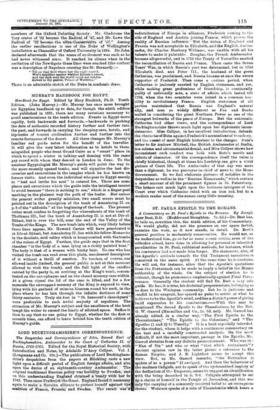MURRAY'S HANDBOOK FOR EGYPT.
Handbook for Egypt. Edited by Mary Brodrick, Ph.D. Tenth Edition. (John Murray.)—Mr. Murray has once more brought his Egyptian handbook up to date, for though the ninth edition was published in 1891, there are many revisions necessary to avoid anachronisms in the tenth edition. Events in Egypt move rapidly, both backwards and forwards.—backwards in pushing the date of authentic recorded history further and further into the past, and forwards in carrying the sleeping-cars, hotels, and hip-baths of tourist civilisation further and further into the remote fastnesses of the desert. All these changes Mr. Murray's familiar red guide notes for the benefit of the traveller. It will give the very latest information as to hotels to those misguided people who treat Grand Cairo as a "smart" place in which to spend a winter in talking and dancing with the same gay crowd with whom they danced in London in June. To the amateur Egyptologist Mr. Murray's guide will point the way to the more recently opened tombs, and will signalise the last dis- coveries and excavations in the temples which he hes known on former visits. And even the individual who goes to Egypt merely to "loaf and invite his soul" is catered for. There are some places and excursions which the guide tells the intelligent tourist to avoid because "there is nothing to see," which is a finger-post marking in the plainest way the path of the loafer. But unless the present writer greatly mistakes, two small errors must be pointed out in the description of the tomb of Amenhotep II. on p.8 of the" addenda" at the beginning of the book. The present writer must confess to forgetting the whereabouts of the tomb of Thothmes III., but the tomb of Amenhotep II. is not at Der-el- Milan, but is over the hill, near the end of the Valley of the Tombs of the Kings. The new tomb into which, very likely before these lines appear, Mr. Howard Carter will have penetrated is at Dar-el- Bahari, but Amenhotep II. lies with his fellow-Monarchs in the desolate, arid valley which is honeycombed with the tombs of the rulers of Egypt. Further, the guide says that in the first chamber "is the body of a man lying on a richly painted boat." The body is that of a woman with bushy hair. No one who has visited the tomb can read even this plain, uncoloured description of it without a thrill of emotion. No torches, of course, are allowed inside (indeed, the general public is not at this moment allowed to visit the tomb), and the full light of the candles carried by the party is, on arriving at the King's tomb, concen- trated on the sarcophagus and on the closed mummy case within. At a given signal the lid of the case is lifted, and for a few momenta the enwrapped mummy of the King is exposed to view, lying with his garland of mimosa blossom round his neck, in the place where he has lain through the infinite darkness of some thirty centuries. Truly six feet in "St. Innocent's churchyard" were preferable to such awful majesty of sepulture. The attraction of Mr. Murray's subject and the excellence of the book tempt the writer to exceed the limits of allotted space. Suffice it then to say that no one going to Egypt, whether for the first or seventh time, can afford to leave behind him the tenth edition of Murray's guide.


















































 Previous page
Previous page